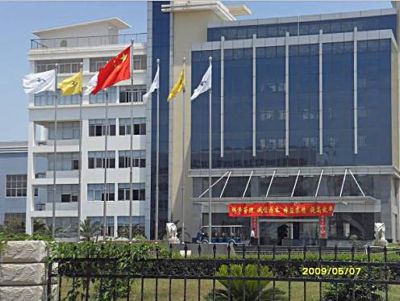
FiberChem's showroom exhibits the diverse applications of its uniform microfiber leather. Photo by David Leoy.
SYNTHETIC LEATHER maker FibreChem Technologies produces fabric that bears high semblance to deer hide but sells for less than half the price of genuine leather.
About 40% of FibreChem’s 1Q08 sales came from its synthetic leather, which is of a grade that is technically known as uniform microfibre leather.
Rolled out in end 2006, its uniform microfibre leather gives a touch of glamour to the mass consumer products, from upholstery and car interiors to fashion apparel, shoes, boots and gloves.
Fibrechem happens to be China’s only manufacturer of such high-grade synthetic leather, which it makes available at less than Rmb 100 per meter.
There is competition from Japanese and Korean manufacturers, but they charge the equivalent of Rmb 150 to Rmb 200 per meter on the average.

FibreChem's uniform microfiber leather is top grade among synthetic leather. Above: market share of synthetic leather types from unverified sources.
”We set our prices at introductory levels to penetrate the market. This also gives us room for upward price adjustment,” explained FibreChem’s financial controller Christopher Tan.
The other 60% or so of sales come from "bi-component fiber", which is spun and woven into synthetic fabric that mimics the real thing, and improves on its price and quality.
Illustration 1: Wool currently sells at Rmb 60,000 a ton, but synthetic fabric made from bi-component fiber can exhibit the fluffiness, breath-ability and softness of the animal fiber at half price.

FibreChem's sea-island bi-component short fiber is made into uniform microfiber leather (above). Photo by David Leoy.
FibreChem is China’s largest manufacturer in differential bi-component fiber, with a total production capacity exceeding 80,000 tons per annum by the beginning of 2009.
Technology behind bi-component fiber
The term “bi-component” offers a clue to the fiber’s structure, which is formed using two components (such as nylon and polyester) instead of just one.
Illustration 2: By coating polyester (which costs less) with nylon, the low-cost nylon alternative is formed, exhibiting similar elasticity and softness.
| End Applications | Cross section of FibreChem’s chemical fibers | |
| 1. Cotton and wool substitute, used in high-end fashion apparel, towels, bathrobes and athletic wear. | Differential bi-component long fiber | |
| 2. Substitute for common grade nylon that can be used to make socks, stockings, lingerie, curtains, etc. | Core sheath bi-component long fiber | |
3. Synthetic leather | Uniform sea-island bi-component short fiber (feedstock for the company’s uniform microfibre leather) |
"FibreChem has the technology to develop new bi-component chemical fibres that can be made into fabrics exhibiting new and innovative properties,” said Financial PR managing director Kathy Zhang, when asked what attracted investors to the synthetic fiber maker.
Financial PR recently organised a trip for 11 investors to Chinese factories which operate along various stages of the textile supply chain.
Top on the investors’ minds were whether margins could be sustained in the face of rising operating costs.
Other than upward price revision, FibreChem will start producing its own polyester chips (a petroleum by-product), which will be one of the feedstocks for its bi-component fibers.
The company’s facilities for 100,000 tons of polyester chips a year will be operational by end 2008.
Christopher expects this upstream integration to expand product innovation capabilities. Initially, there will be excess capacity which can be sold in the market.
"It is unique in integrating several stages of the textile supply chain, from production of polyester chips, to spinning of fibers and yarn, right down to the production of the finished fabric in the case of microfiber leather,” concluded Kathy.

Kathy led 11 investors to see the above companies (excluding BASF & Dupont) on textile supply chain
Photos from the plant visit taken by David Leoy
 Computer screen shows magnified fiber cross section |  Short fiber production prior to stretching. |
 Production of non-woven fabric - the base material for microfibre leather. |  Microfibre leather under post-production treatment. |
Read other reports about companies visited on the textile sector investigative trip:
LI HENG: Visit to leading Chinese nylon producer
CHINA HONGXING: Top-selling tennis shoe maker
CHINA TAISAN: Synthetic fabric maker's 1Q08 earnings up 3-fold
CHINA TAISAN: Gaining foothold in sports apparel industry
CHINA ZAINO: No.1 China backpack brand moves into luggage space


